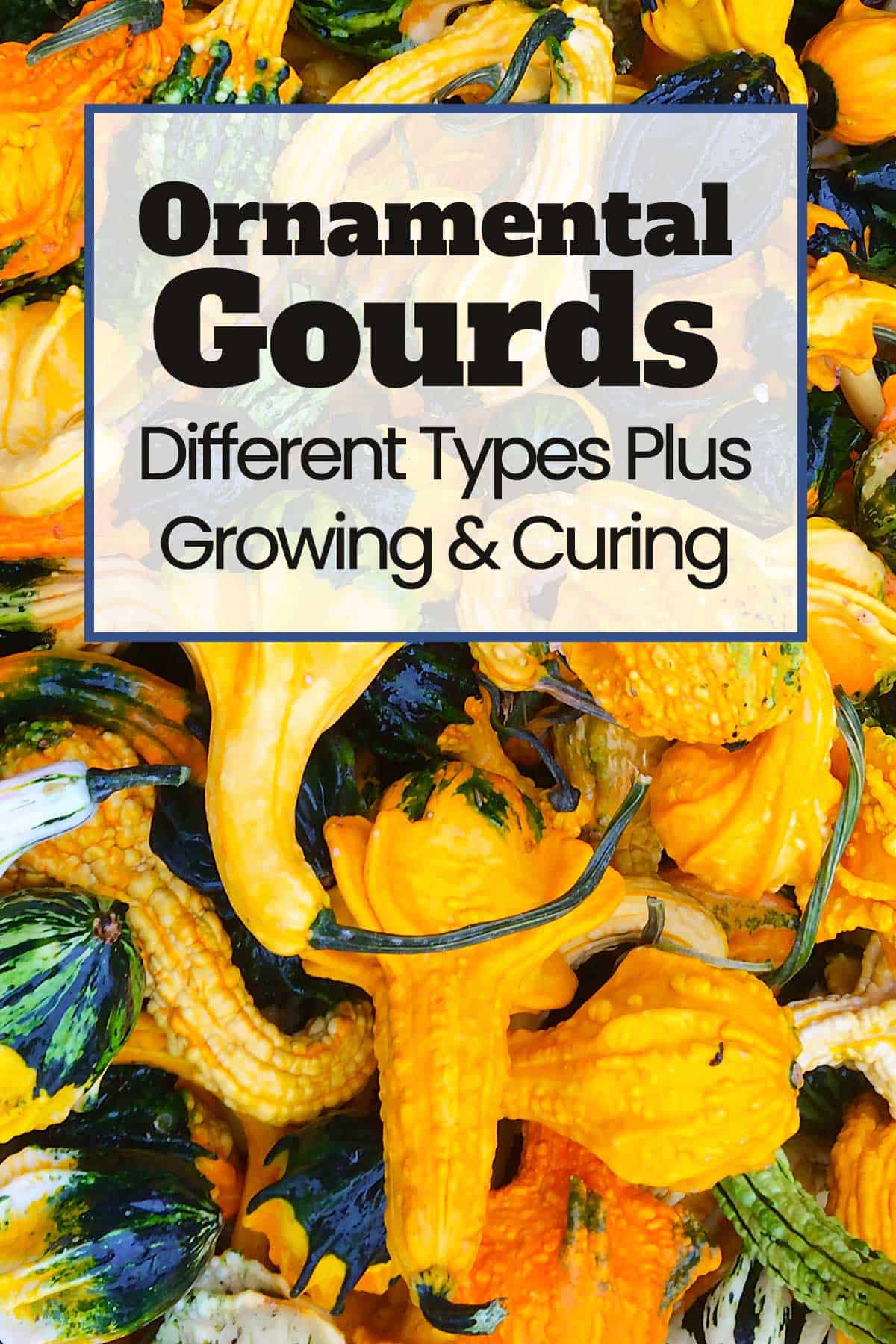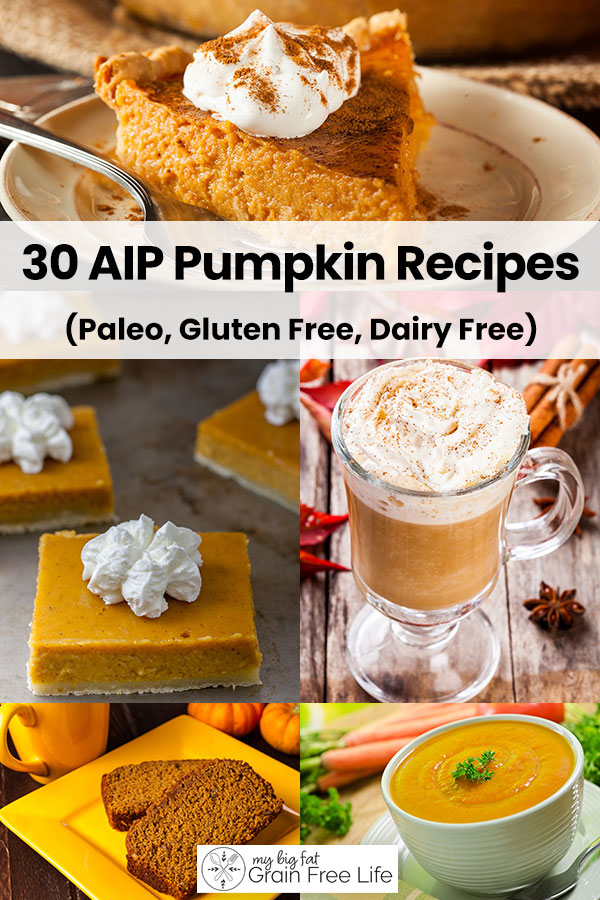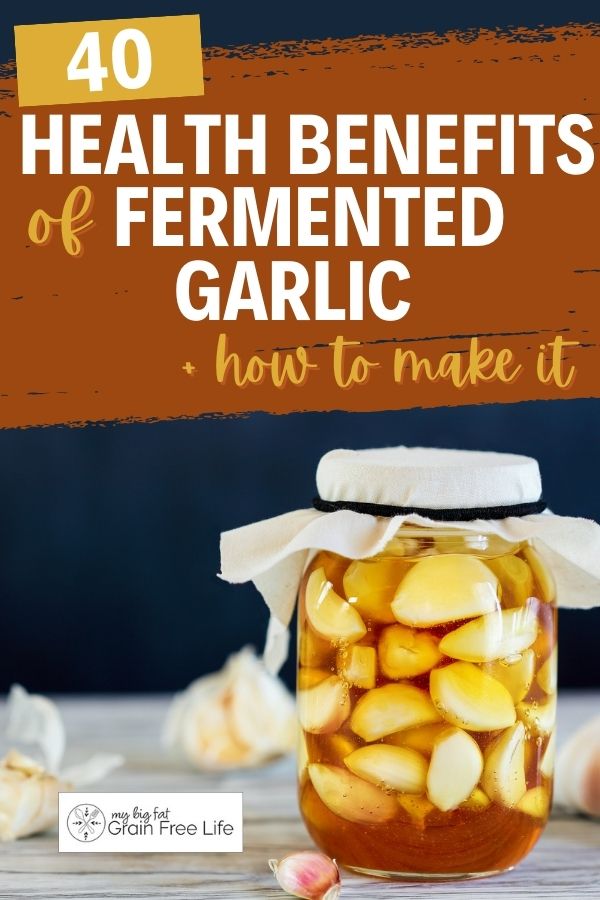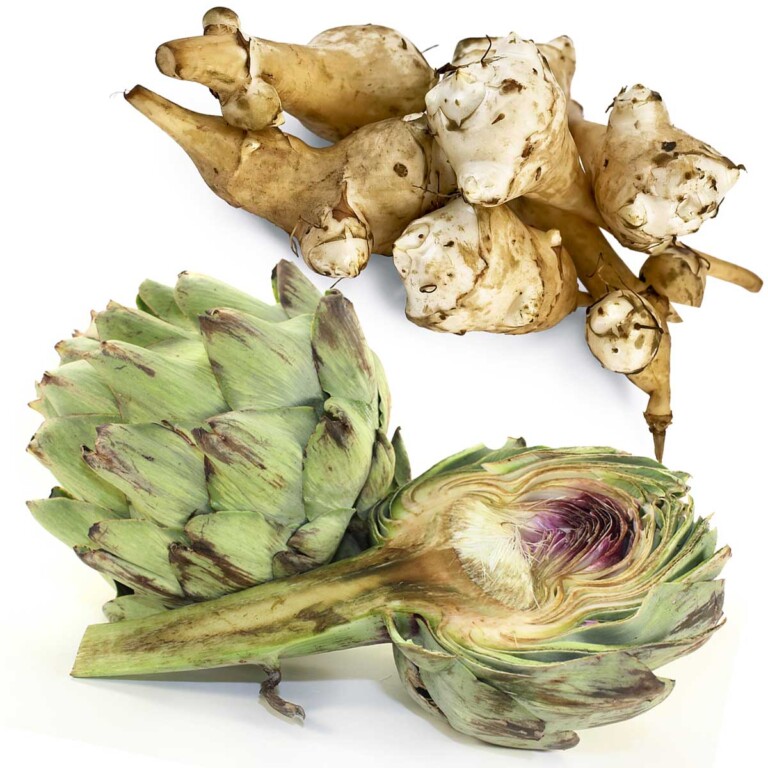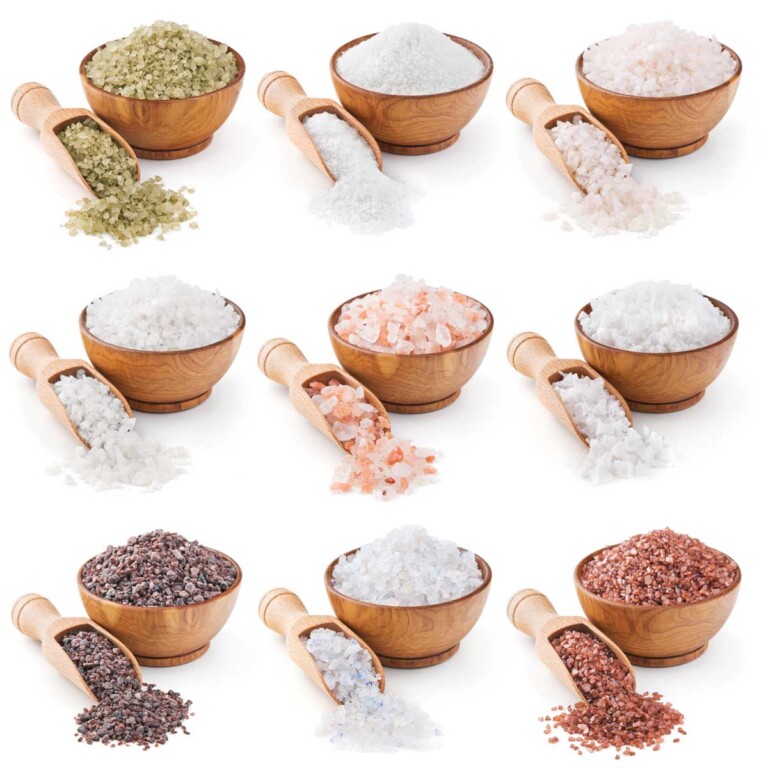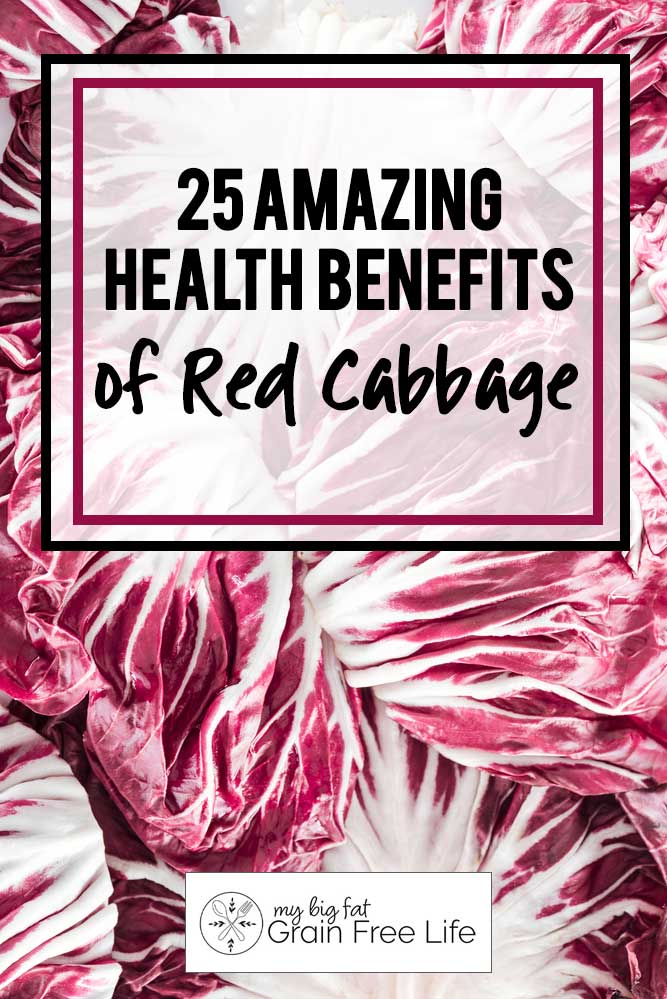67 Different Types of Squash (Summer & Winter Varieties)
This post may contain affiliate links. If you make purchase after clicking a link, I may receive a commission at no extra cost to you.
Last Updated on September 23, 2023
It’s a little crazy how many different types of squash there are. Some you may never had heard of! Learn about 67 types of squash, broken down into summer squash and winter squash varieties. Discover facts on appearance, taste, uses, and health benefits.
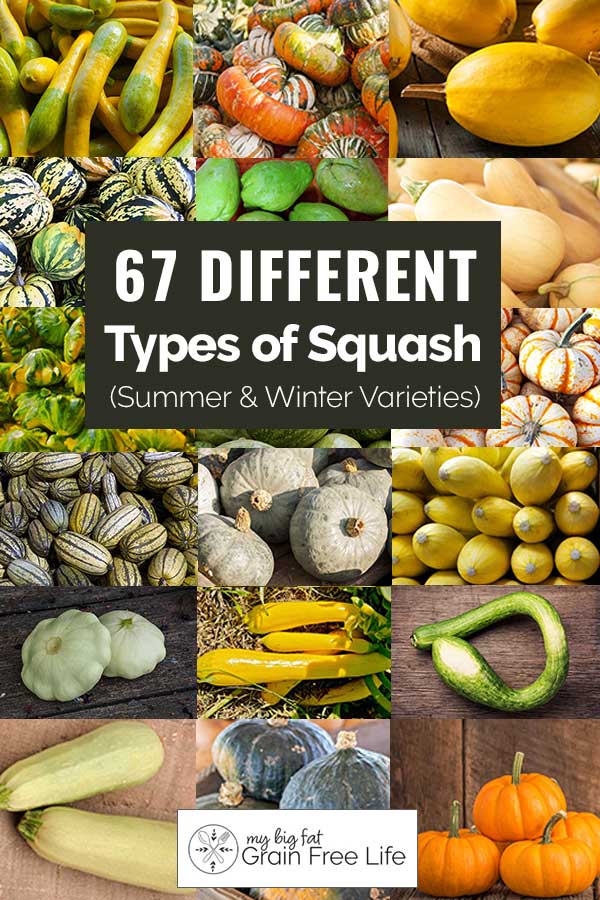
Types of Squash
I bet you had no idea there were so many different types of squash! There’s summer squash and winter squash, and each type of squash includes dozens of different varieties of squash.
We’re going to cover everything you need to know about squash, including appearance, characteristics, health benefits, choosing the best squash, storing squash, and more.
First, let’s learn what squash is!
What is a Squash?
Squash, which encompasses several varieties under the Cucurbitaceae family, is a versatile and nutritious vegetable that can be incorporated into a plethora of dishes.
They are generally segmented into two categories: summer and winter squash. Despite their names, both types are grown and harvested in the summer, albeit winter squash is harvested late summer to autumn.
Summer Squash Vs. Winter Squash
Summer squash is characterized by its soft, edible skin and seeds – think of zucchinis and yellow crooknecks. Given their high water content, they’re usually best when harvested young and cooked soon after.
Winter squash, on the other hand, is distinguished by its hard, inedible outer shell which allows for longer storage. Pumpkins, butternuts and acorns fall under this type. They tend to have a robust, sweet flavor and a starchy texture, making them ideal for heart-warming soups, roasts and pies.
67 Types of Squash
We will take a look at lots of different types of squash below. To make it easy to understand the various squash types, we have broken it down into two categories: summer squash and winter squash.
Summer Squash Types
Summer squash, as the name implies, is a variety of squash that is typically harvested during the summer months.
This vegetable is a member of the Cucurbitaceae family, which also includes cucumbers and melons. There are many ypes of summer squash, including zucchini, yellow squash, patty pan squash, yellow crookneck, and more.
Summer squash is characterized by its tender, edible skin, soft seeds, and generally mild flavor. It’s rich in many essential nutrients such as vitamin A, vitamin C, and dietary fiber, making it a beneficial addition to a balanced diet.
In terms of its cultivation, summer squash plants are typically bushy, not vining like some other squash varieties, and they mature relatively quickly. This allows multiple crops to be harvested throughout the summer season.
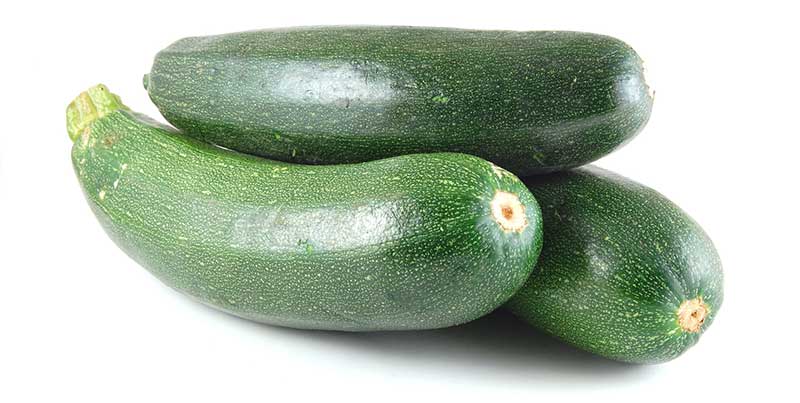
Zucchini
Zucchini has a mild, slightly sweet flavor with a tender and crisp texture. It is green in color, cylindrical in shape, and can be harvested at various sizes. Zucchini is low in calories, high in fiber, and packed with vitamins A and C.
I enjoy spiralizing zuchinni, like I do for my zucchini pasta salad recipe.
Yellow Crookneck Squash
Crookneck squash has a buttery, nutty flavor and a firm yet tender texture. It is yellow in color, with a curved neck and a bulbous base. This type of summer squash is a good source of potassium, magnesium, and vitamin B6.
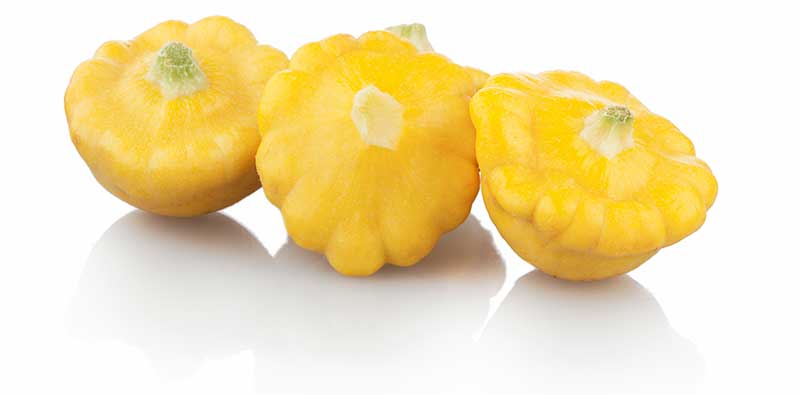 Pattypan Squash
Pattypan Squash
Pattypan squash has a delicate, slightly sweet flavor and a firm, creamy texture. It comes in various colors, including white, yellow, and green, and resembles a flying saucer in shape. Pattypan squash is rich in antioxidants, vitamins A and C, and dietary fiber.
Yellow Straightneck Squash
Yellow straightneck squash has a mild, subtly sweet flavor and a tender, smooth texture. It is elongated and straight, with a bright yellow color. This type of summer squash is low in calories and a good source of vitamin C, manganese, and folate.
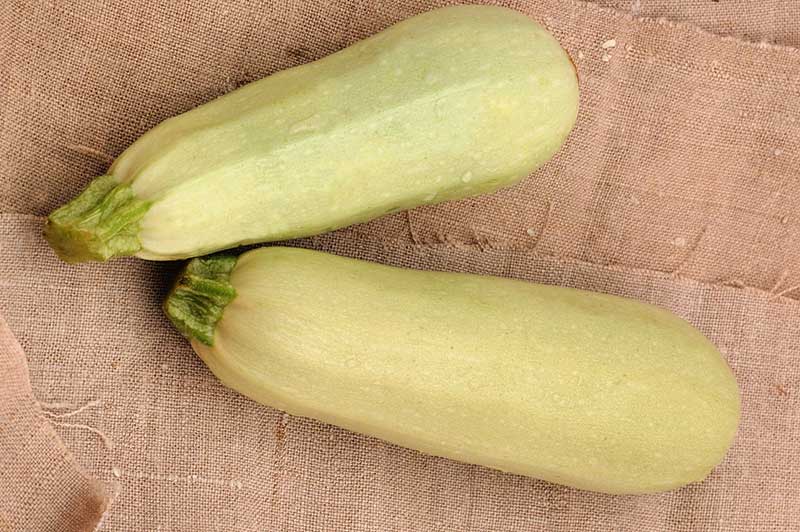
Cousa Squash
Cousa squash has a mild, nutty flavor and a tender, slightly crunchy texture. It is pale green or yellow in color, with a cylindrical shape and tapered ends. Cousa squash is rich in antioxidants, vitamin A, and potassium.
Tat soi Squash
Tat soi squash has a mild, slightly sweet flavor and a tender, crisp texture. It is green in color, with spoon-shaped leaves. Tat soi squash is low in calories, high in fiber, and packed with vitamins A and C.
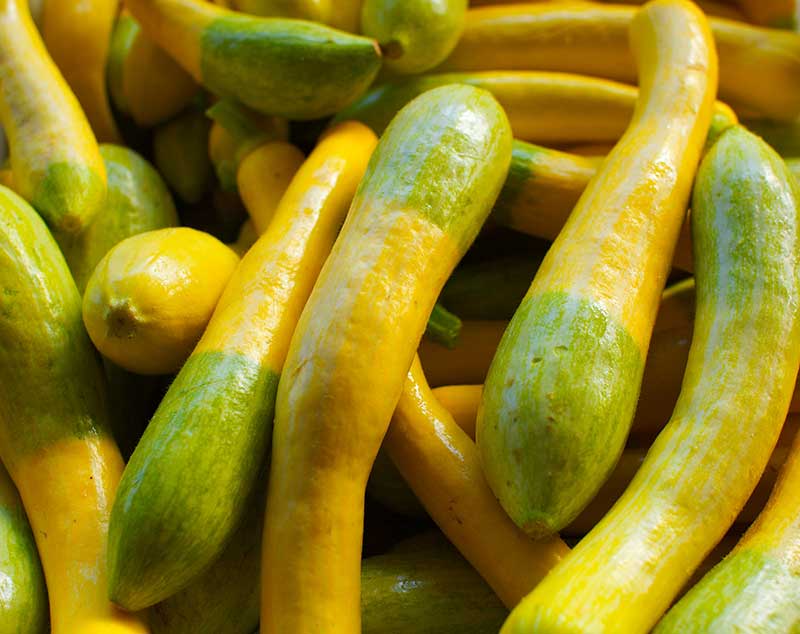
Zephyr Squash
Zephyr squash has a sweet, buttery flavor and a firm, creamy texture. It has a unique appearance, with a blend of yellow and green colors in a curved shape. Zephyr squash is low in calories, high in fiber, and a good source of vitamin C and manganese.
Romanesco Squash
Romanesco squash has a mild, nutty flavor and a firm, dense texture. It is pale green in color, with ridges running from top to bottom. Romanesco squash is low in calories, high in fiber, and a good source of vitamin C and potassium.
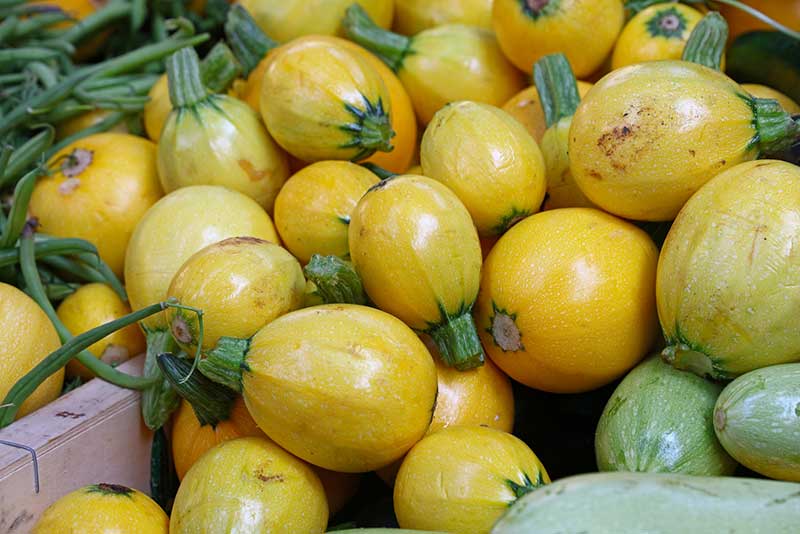
Yellow Globe Squash
Yellow globe squash has a mild, slightly sweet flavor and a tender, smooth texture. It is round in shape and has a bright yellow color. This type of summer squash is low in calories and packed with vitamins A and C.
Tatume Squash
Tatume squash has a sweet, nutty flavor and a firm, dense texture. It is cylindrical in shape, with a mottled green color. Tatume squash is low in calories and packed with vitamins A and C.
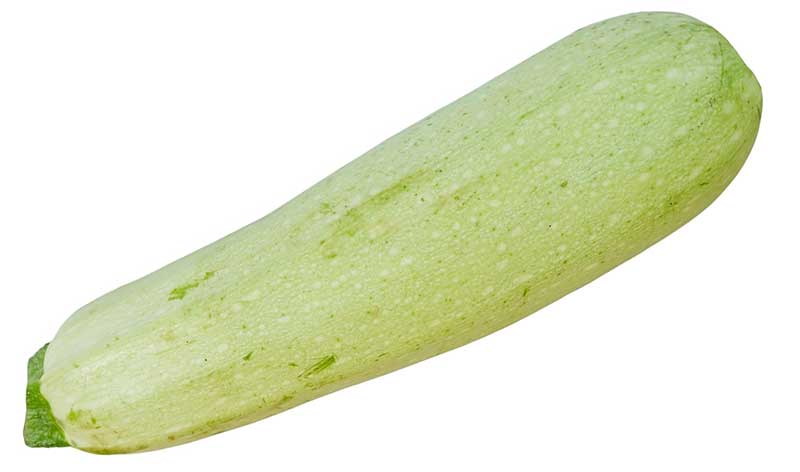
Lebanese Squash
Lebanese squash has a mild, slightly sweet flavor and a tender, crisp texture. It is pale green in color, elongated, and slender. Lebanese squash is low in calories, high in fiber, and packed with vitamins A and C.
Starship Squash
Starship squash has a mild, subtly sweet flavor and a tender, smooth texture. It is elongated and straight, and has a yellow color. This type of summer squash is low in calories and a good source of vitamin C, manganese, and folate.
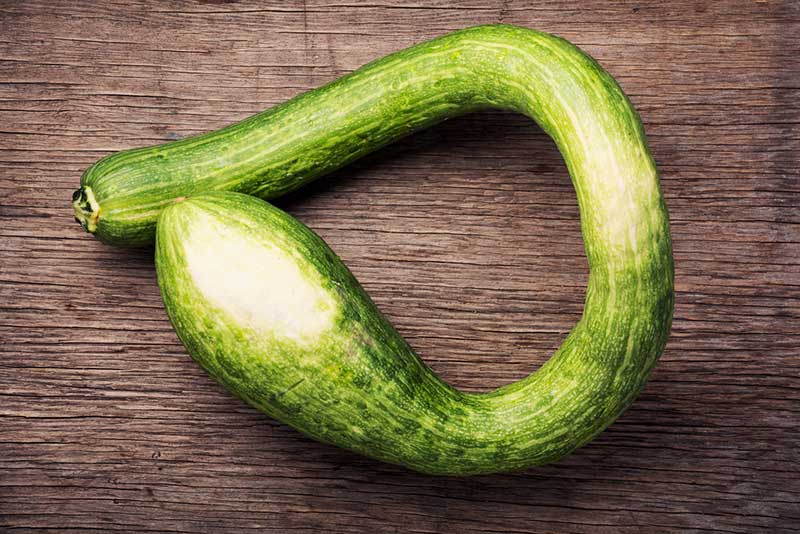
Tromboncino Squash
Tromboncino squash has a nutty, sweet flavor and a firm, dense texture. It is long and curved, resembling a trombone. Tromboncino squash is low in calories, high in fiber, and a good source of vitamins A and C.
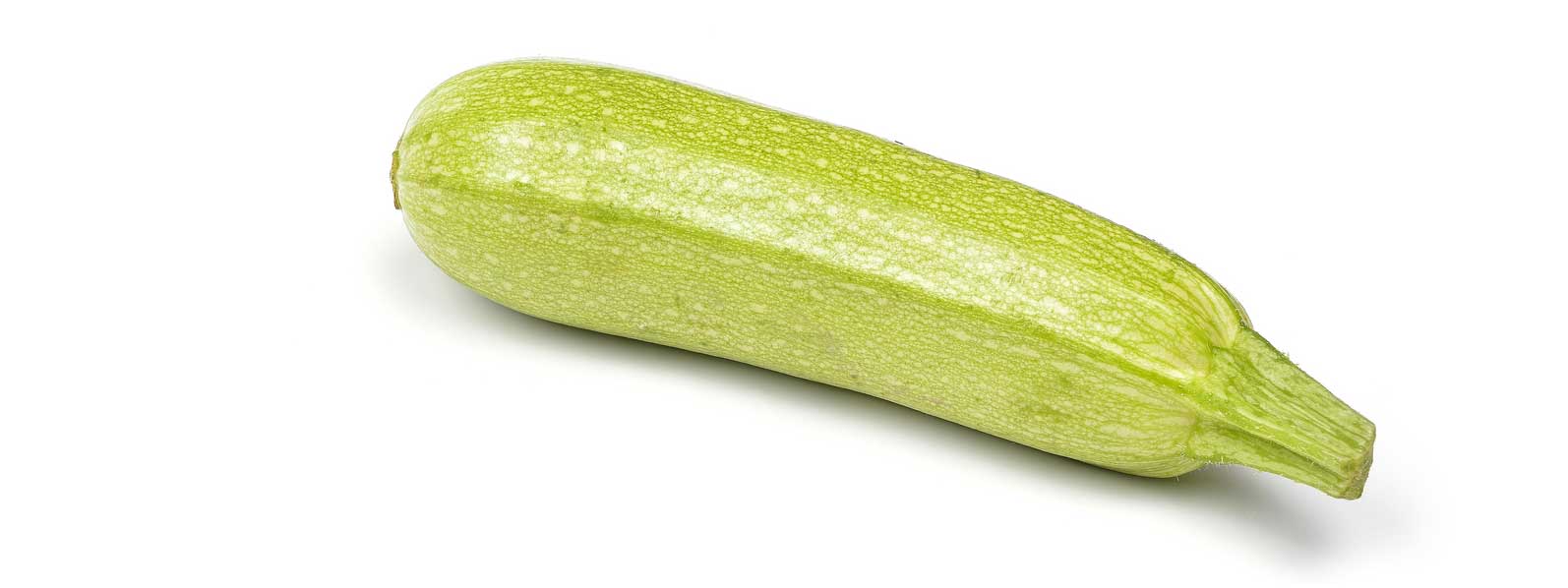
Magda Squash
Magda squash has a mild, slightly sweet flavor and a tender, crisp texture. It is pale green in color, elongated, and slender. Magda squash is low in calories, high in fiber, and packed with vitamins A and C.
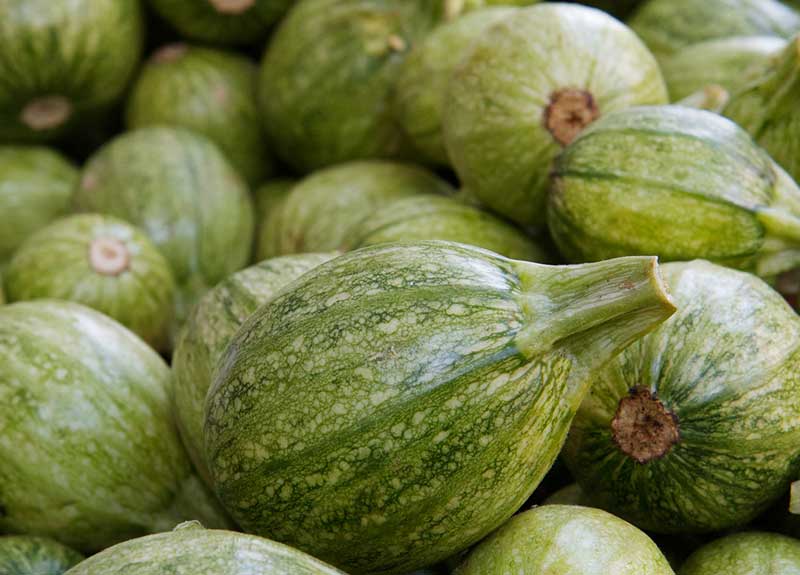
Ronde de Nice Squash
Ronde de Nice squash has a mild, slightly nutty flavor and a tender, creamy texture. It is round in shape, medium-sized, with a green color. Ronde de Nice squash is low in calories and packed with vitamins A and C.
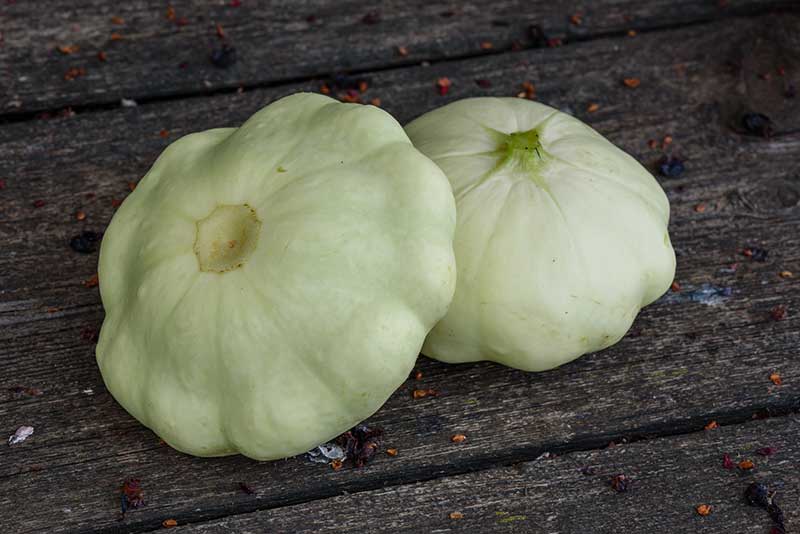
Benning’s Green Tint Scallop Squash
Benning’s green tint scallop squash has a delicate, slightly sweet flavor and a tender, creamy texture. It is flat and scallop-shaped, with a light green color. Benning’s green tint scallop squash is rich in antioxidants, vitamins A and C, and dietary fiber.
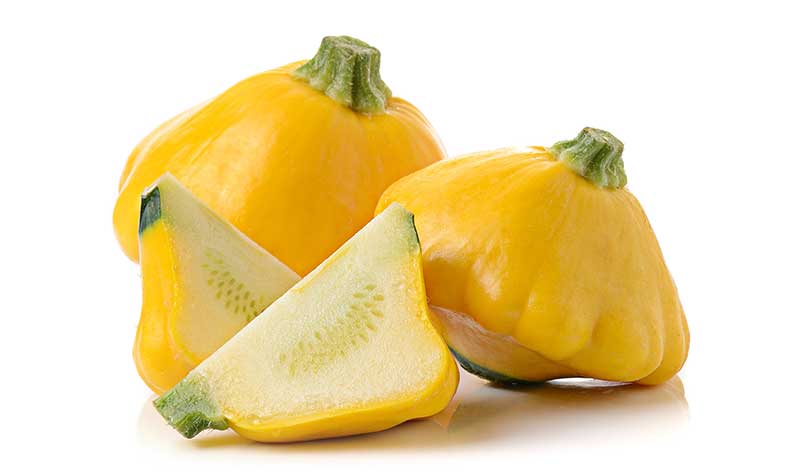
Sunburst Squash
Sunburst squash has a mild, slightly sweet flavor and a tender, crisp texture. It is yellow in color, with a sunburst pattern on its skin. Sunburst squash is low in calories, high in fiber, and packed with vitamins A and C.
Banana Squash
Banana squash is a large, elongated squash with a sweet and nutty flavor. It has a dense and creamy texture, making it ideal for baking or roasting. Visually, it has a yellow or orange skin and a pale, tender flesh. In terms of health benefits, banana squash is a great source of vitamins A and C, as well as dietary fiber.
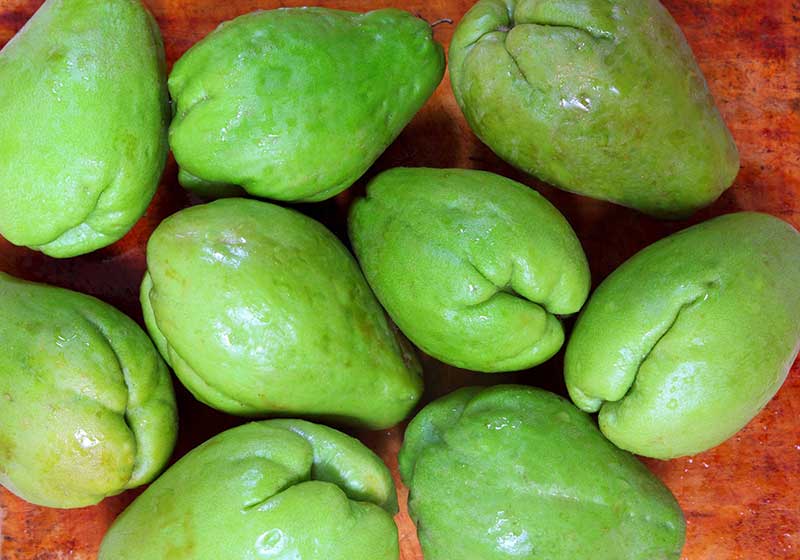
Chayote Squash
Chayote squash, also known as vegetable pear, has a mild and crisp flavor reminiscent of cucumber or zucchini. It has a firm, yet tender texture, making it perfect for salads or stir-fries.
Chayote squash features a pale green, wrinkled skin and a pale flesh. This squash variety is low in calories and packed with essential nutrients like vitamin K and folate.
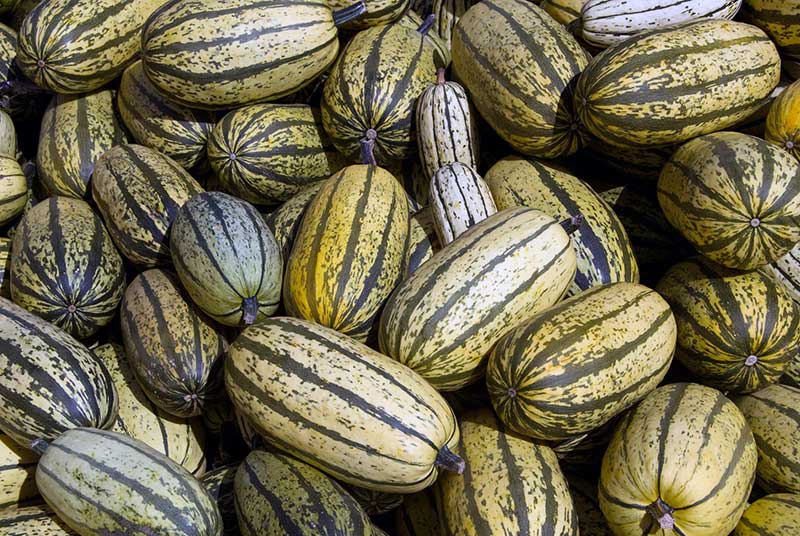
Delicata Squash
Delicata squash has a mild andsweet flavor reminiscent of sweet potatoes. It has a soft and smooth texture, and its skin features green or yellow stripes on a cream-colored background. This squash is a good source of dietary fiber and vitamin C, aiding digestion and supporting the immune system.
Clarimore Squash
Clarimore squash has a mild, slightly sweet flavor and a tender, crisp texture. It is green in color, elongated, and slender. Clarimore squash is low in calories, high in fiber, and packed with vitamins A and C.
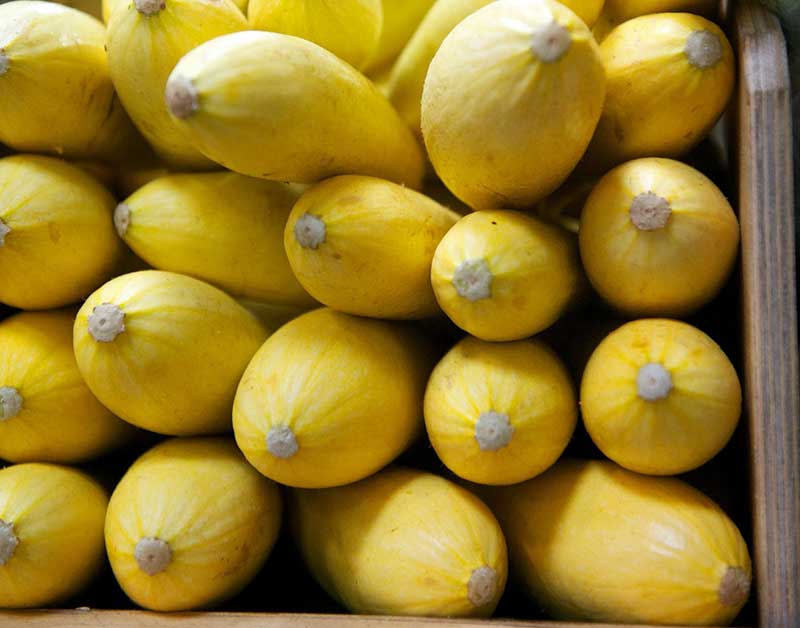
Yellow Squash
Yellow squash is a summer squash with a subtle and slightly sweet flavor. It has a tender and moist texture, making it suitable for sautéing or grilling. Yellow squash is characterized by its bright yellow skin and creamy white flesh. This squash type is rich in antioxidants, vitamins A and C, and minerals like potassium and magnesium.
Green Egg Squash
Green egg squash, also known as pattypan squash, has a delicate and buttery flavor. It has a firm and slightly grainy texture that holds up well when cooked. Green egg squash is easily recognizable by its small, round shape and scalloped edges. This squash variety is a good source of dietary fiber, vitamin B6, and manganese.
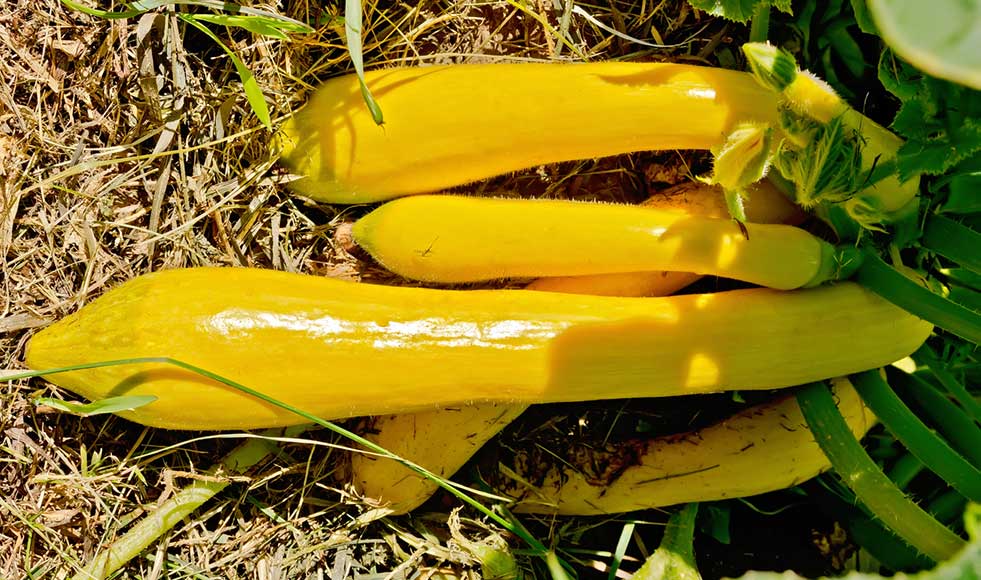
Gold Rush Squash
Gold rush squash, a winter squash variety, has a sweet and nutty flavor with a hint of buttery undertones. It has a smooth and creamy texture that becomes even richer when cooked. Gold rush squash features a golden yellow skin and an orange flesh. This squash type is high in antioxidants, vitamins A and C, as well as fiber.
Scallop Trio Squash
Scallop trio squash has a delicate, slightly sweet flavor and a tender, creamy texture. It comes in various colors, including white, yellow, and green, and is flat and scallop-shaped. Scallop trio squash is rich in antioxidants, vitamins A and C, and dietary fiber.
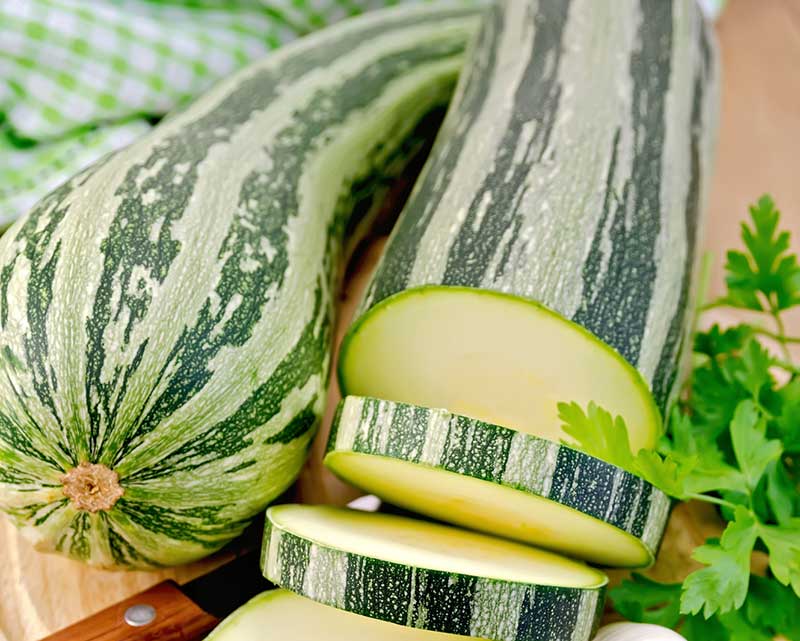
Cocozelle Squash
Cocozelle squash has a mild, slightly nutty flavor and a tender, crisp texture. It is elongated, with dark green stripes on a lighter green background. Cocozelle squash is low in calories, high in fiber, and a good source of vitamins A and C.
Sure Thing Zucchini
Sure thing zucchini has a mild, slightly sweet flavor and a tender, crisp texture. It is green in color, cylindrical in shape, and can be harvested at various sizes. Sure thing zucchini is low in calories, high in fiber, and packed with vitamins A and C.
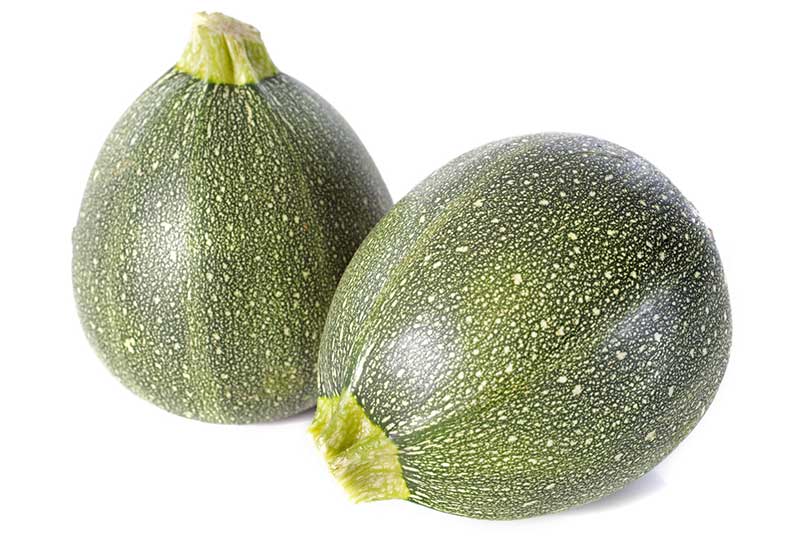
Eight Ball Zucchini
Eight ball zucchini has a sweet, nutty flavor and a firm, dense texture. It is small and round, resembling a billiard ball, with a dark green color. Eight ball zucchini is low in calories and an excellent source of vitamin A.
Butterstick Squash
Butterstick squash has a buttery, nutty flavor and a firm yet tender texture. It is yellow in color, with a cylindrical shape and can be harvested at various sizes. Butterstick squash is a good source of potassium, magnesium, and vitamin B6.
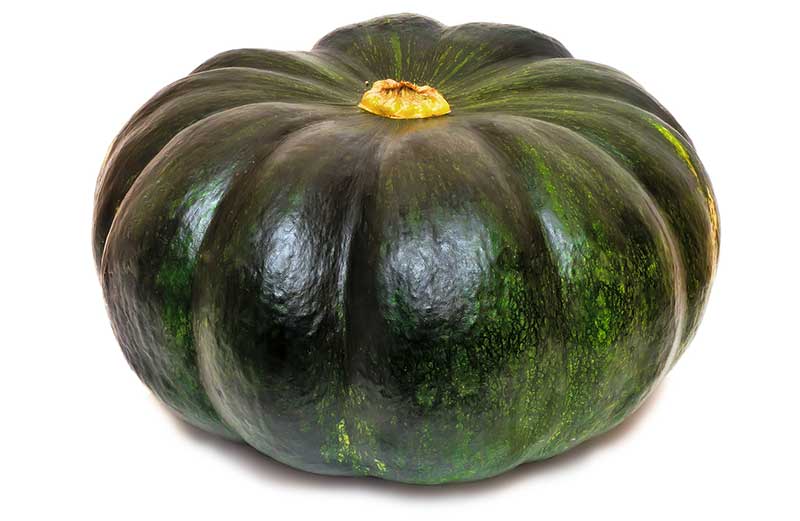
Cupcake Squash
Cupcake squash has a mild, slightly sweet flavor and a tender, creamy texture. It is round in shape, with a dark green color. Cupcake squash is low in calories and packed with vitamins A and C.
Dunja Squash
Dunja squash has a mild, subtly sweet flavor and a tender, smooth texture. It is yelllow, elongated and straight. This type of summer squash is low in calories and a good source of vitamin C, manganese, and folate.
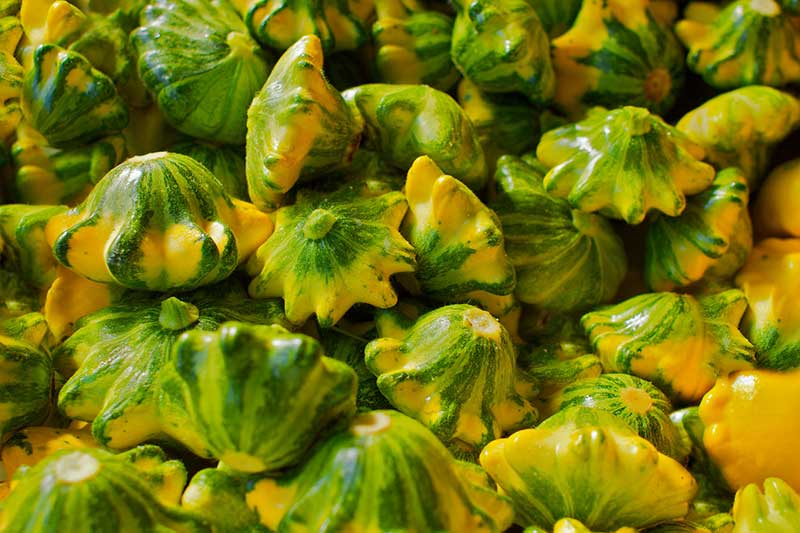
Flying Saucer Squash
Flying saucer squash has a delicate, slightly sweet flavor and a tender, creamy texture. It comes in various colors, including white, yellow, and green, and resembles a flying saucer in shape. Flying saucer squash is rich in antioxidants, vitamins A and C, and dietary fiber.
Green Machine Squash
Green machine squash has a mild, nutty flavor and a firm, dense texture. It is pale green in color, with ridges running from top to bottom. Green machine squash is low in calories, high in fiber, and a good source of vitamin C and potassium.
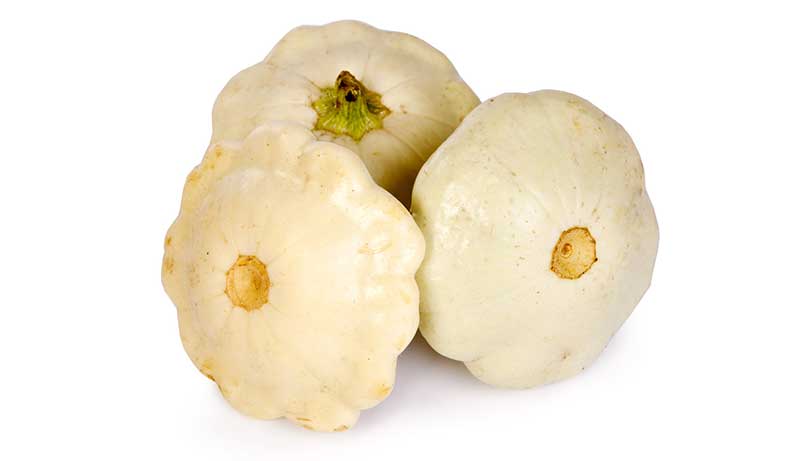
Peter Pan Squash
Peter pan squash has a sweet, nutty flavor and a firm, dense texture. It is small and round, resembling a miniature pumpkin, with a yellow or pale green color. Peter pan squash is low in calories and packed with vitamins A and C.
Winter Squash Types
Winter squash is a term that encompasses several varieties of hard rind squashes that are typically harvested in late summer through autumn, but stays edible throughout the winter months – hence the name.
This category includes popular types like butternut, spaghetti, acorn, and kabocha squash, among others.
These squashes are renowned for their rich, sweet flavor and a texture that ranges from creamy to slightly firm, depending on the specific variety.
Most winter squashes have a bright orange flesh, a testament to their high content of beta-carotene, a powerful, immune-boosting antioxidant.
In fact, winter squashes are a veritable powerhouse of nutrition. They are low in calories yet high in fiber, making them a great ingredient for those seeking weight management. They also boast significant levels of vitamins A, C, and E, as well as potassium and magnesium.
Moreover, winter squashes can be roasted, baked, pureed for soups, or even stuffed. They lend themselves beautifully to both sweet and savory applications, fitting perfectly into a variety of dishes, from comforting AIP soups to holiday desserts.
Winter squash also is great when roasted alongside root vegetables and various tubers, like white sweet potatoes.

Acorn Squash
With a slightly sweet and nutty flavor, acorn squash has a texture that is both tender and fibrous. Its skin is dark green with deep ridges. Rich in vitamin C and magnesium, acorn squash promotes a healthy immune system and supports bone health.

Butternut Squash
Known for its creamy and slightly sweet taste, butternut squash has a smooth texture. Its skin is pale yellow and its shape is elongated with a bulbous bottom. This squash is a great source of vitamin A and potassium, contributing to good eye health and proper heart function.
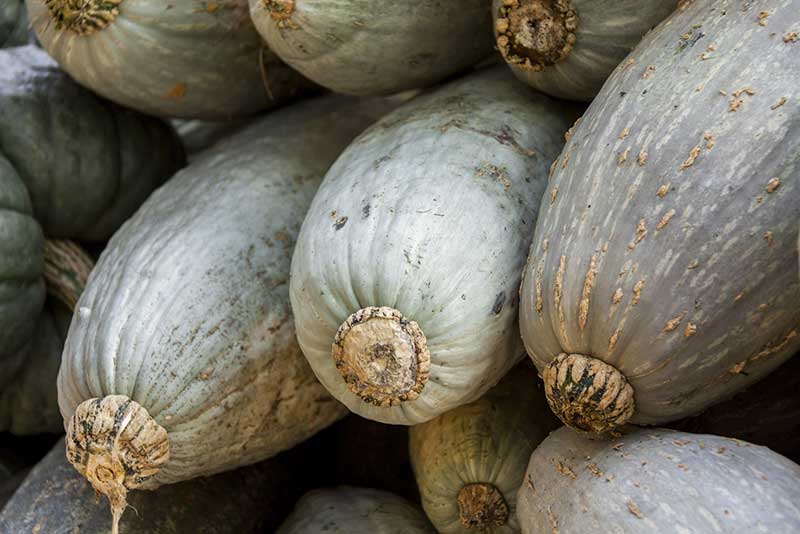
Guatemalan Blue Squash
Guatemalan blue squash, also known as Ayote or Ayote en Paloma, is characterized by its bold blue-green hue and oblong shape. Guatemalan blue squash offers a delicate, mildly sweet taste with nutty undertone.
It is low in calories and high in dietary fiber and is rich in essential vitamins and minerals, including vitamin A, vitamin C, potassium, and manganese.
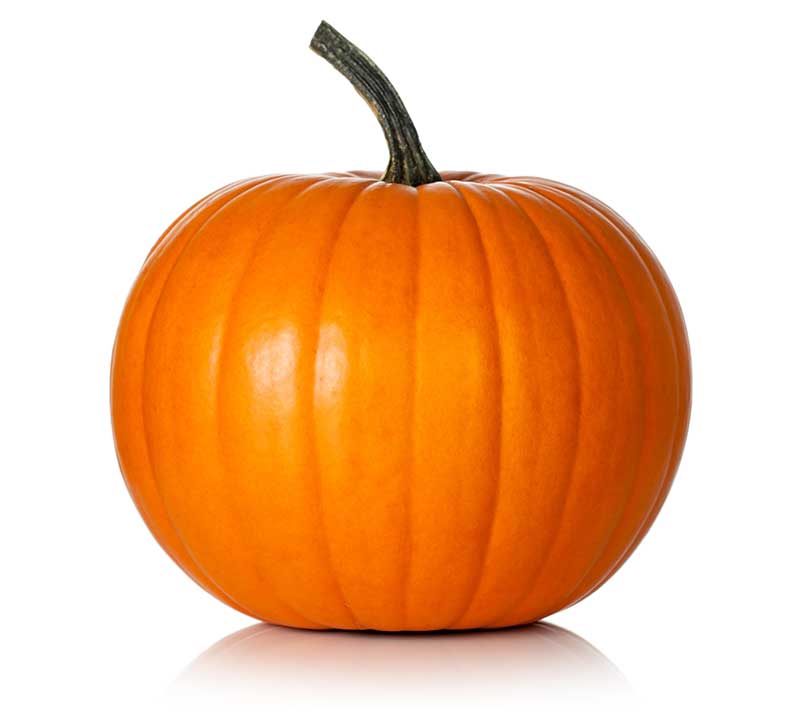
Hijinks Pumpkins
Hijinks pumpkins are small to medium-sized pumpkins with an orange color. They have a sweet flavor and a smooth texture, making them perfect for baking or making pumpkin pies. These pumpkins are rich in vitamins A and C, as well as fiber, which promotes healthy digestion.
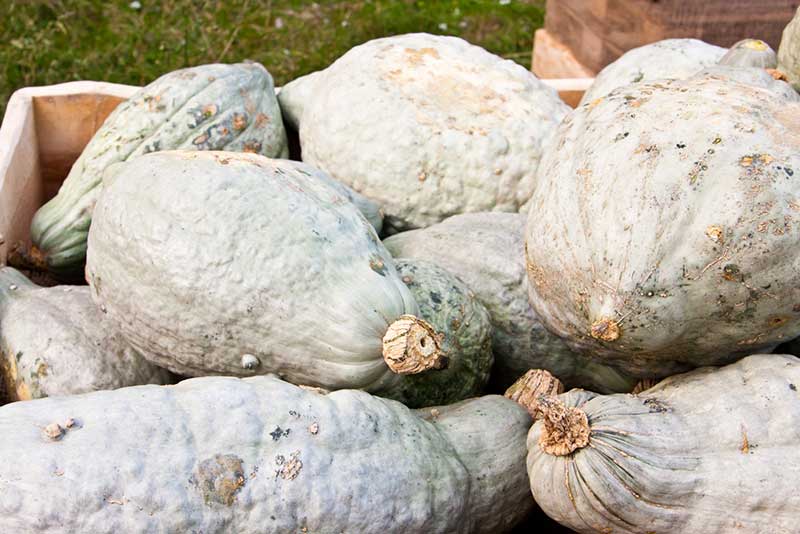
Hubbard Squash
With a sweet and nutty taste, the flesh of a hubbard squash is dense and starchy. The exterior ranges from dark green to orange. High in beta-carotene and vitamin C, Hubbard squash promotes healthy skin and boosts the immune system.
Super Moon Pumpkins
Super Moon pumpkins are large, round, and have a pale orange skin. They have a slightly sweet and nutty flavor with a dense, firm texture. These pumpkins are commonly used for carving or creating decorative displays. They are a good source of antioxidants, vitamins, and minerals, such as potassium and beta-carotene.
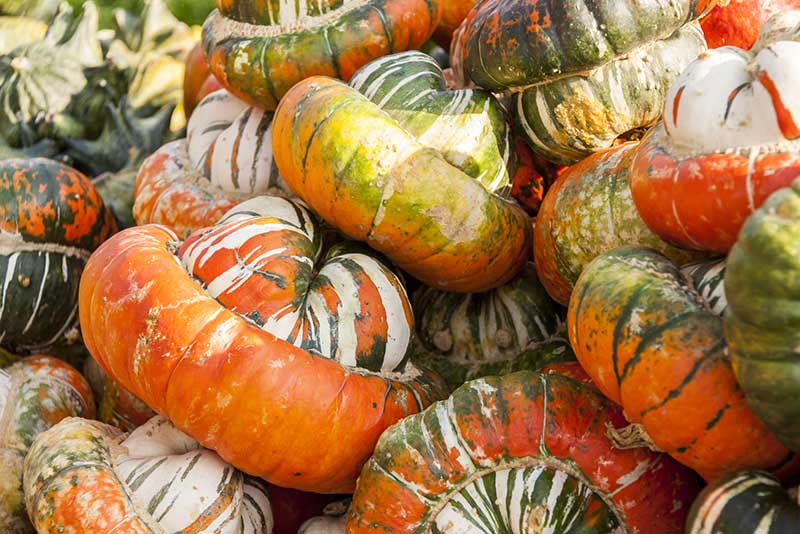
Turban Squash
Turban squash is a winter squash known for its unique shape resembling a turban. Its skin color varies from green to orange with yellow markings. The flesh is golden-yellow and has a mild, sweet flavor similar to butternut squash. Turban squash is often roasted or used in soups. It is rich in vitamins A and C, as well as potassium and fiber.
Yokohama Squash
Yokohama squash, also known as Kuri or Japanese chestnut squash, has a deep red-orange skin with a mottled appearance. It has a sweet, nutty flavor and a smooth, creamy texture. Yokohama squash is commonly used in stews, soups, or roasted as a side dish. It is a good source of vitamins A and C, iron, and fiber.
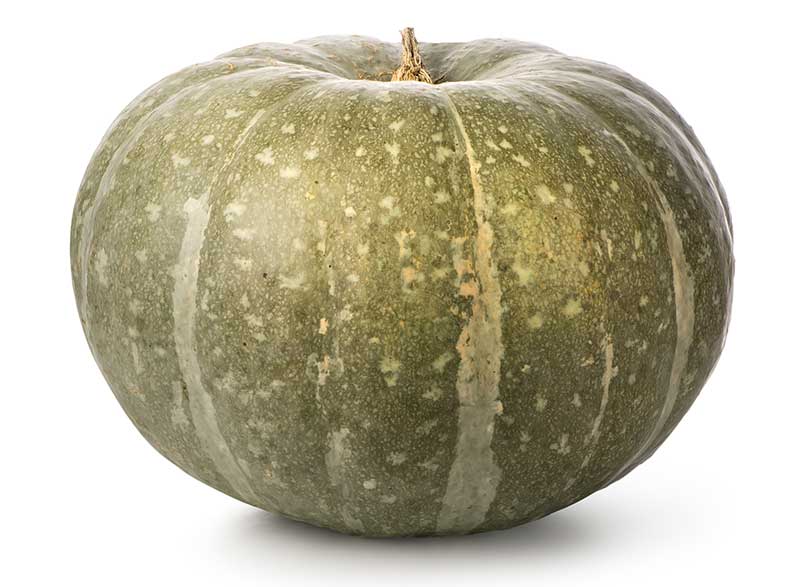
Kabocha Squash
Kabocha squash offers a sweet flavor similar to a sweet potato or pumpkin. Its texture is smooth and velvety. The skin is typically dark green with patches of yellow or orange. This type of squash is rich in antioxidants and dietary fiber, supporting digestion and reducing the risk of chronic diseases.
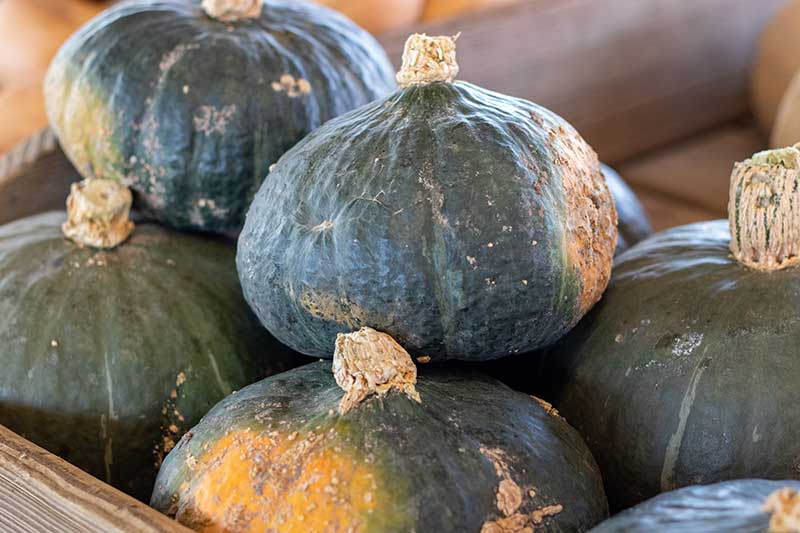
Buttercup Squash
Buttercup squash has a sweet and nutty flavor with a dense and smooth texture. Its skin is dark green with lighter green stripes. This squash is a good source of vitamin A and vitamin C, aiding in healthy vision and immune function.
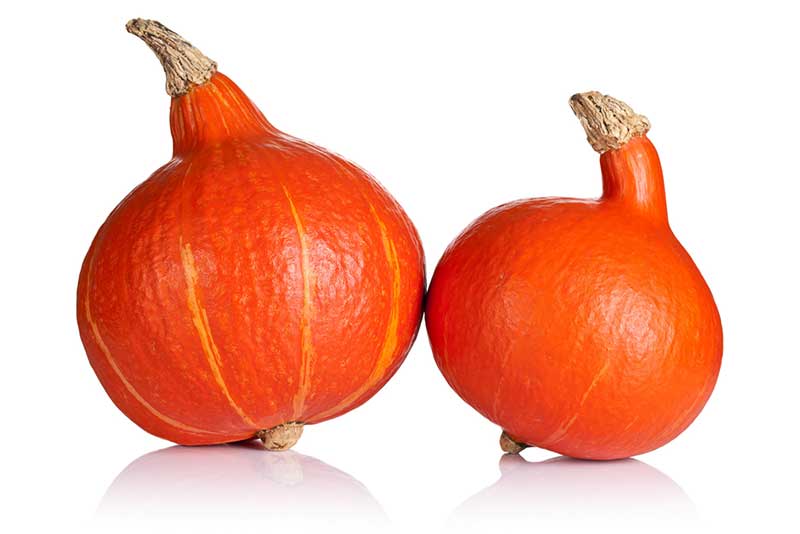
Ambercup Squash
Ambercup squash has a sweet and nutty flavor with a firm, fine-textured flesh. It is small to medium-sized with a dark green skin and orange flesh. Ambercup squash is rich in vitamins A and C, as well as dietary fiber
Atlantic Giant
Atlantic Giant squash has a mild, slightly sweet flavor and a coarse, dense flesh. It is an enormous size squash, often used for contests, with a smooth, deep orange skin. Similar to other orange-fleshed varieties, Atlantic giant squash is a great source of vitamin A and also provides dietary fiber.
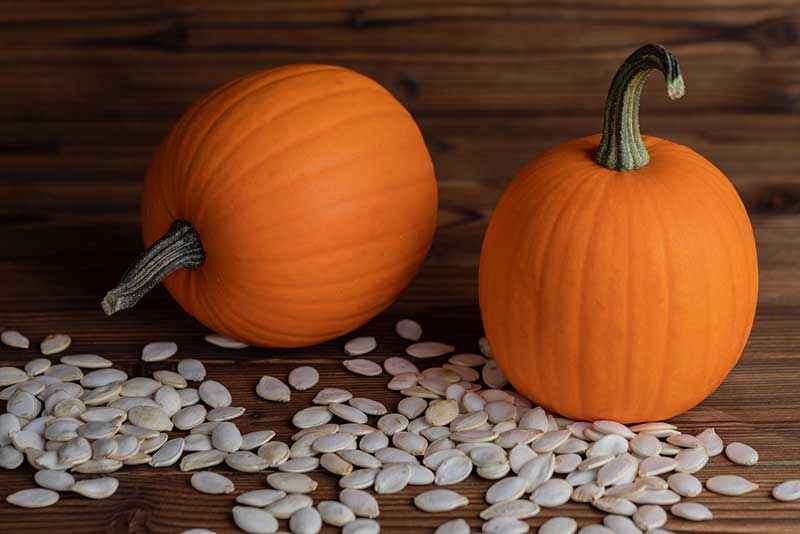
Autumn Gold Pumpkins
Autumn gold pumpkins have a mellow, earthy flavor with a smooth, creamy texture. These pumpkins have a deep orange skin and thick walls. Autumn gold pumpkins are full of antioxidants, vitamins A and C, as well as potassium.
Honey Bear Squash
Honey bear squash is a small, acorn-shaped winter squash with a golden-orange skin. It has a sweet, honey-like flavor and a smooth, creamy texture. Honey bear squash is often roasted, stuffed, or used in soups. It is rich in vitamins A and C, as well as dietary fiber.
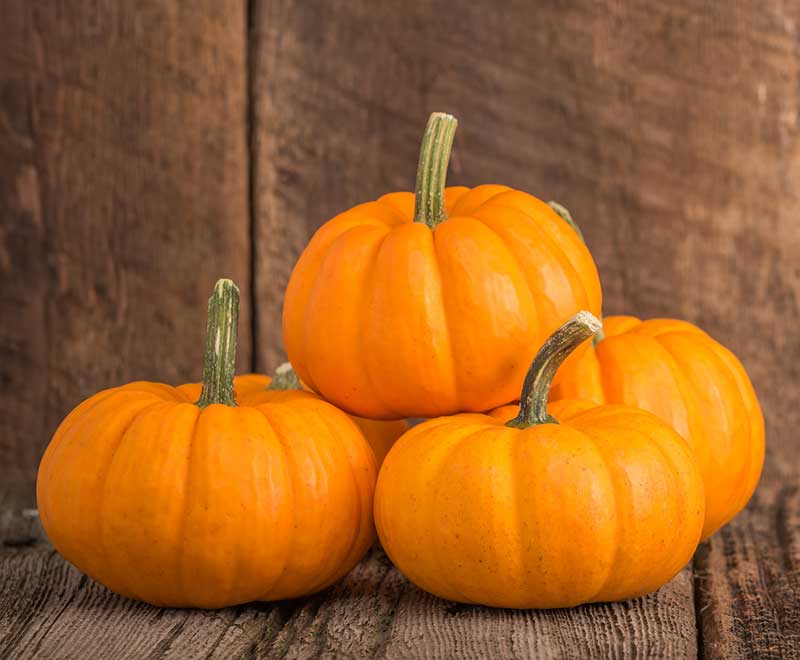
Baby Bear Pumpkins
Baby Bear pumpkins have a sweet and slightly nutty flavor and a smooth and creamy texture. These small pumpkins have deep orange skin with subtle ribbing. Baby bear pumpkins are a good source of dietary fiber and contain vitamin A.
Honeynut Squash
Honeynut squash is a small winter squash resembling a miniature butternut squash. It has a sweet, nutty flavor and a dense, creamy texture. Honeynut squash is often roasted, pureed, or used in soups and casseroles. It is a good source of vitamins A and C, as well as dietary fiber.
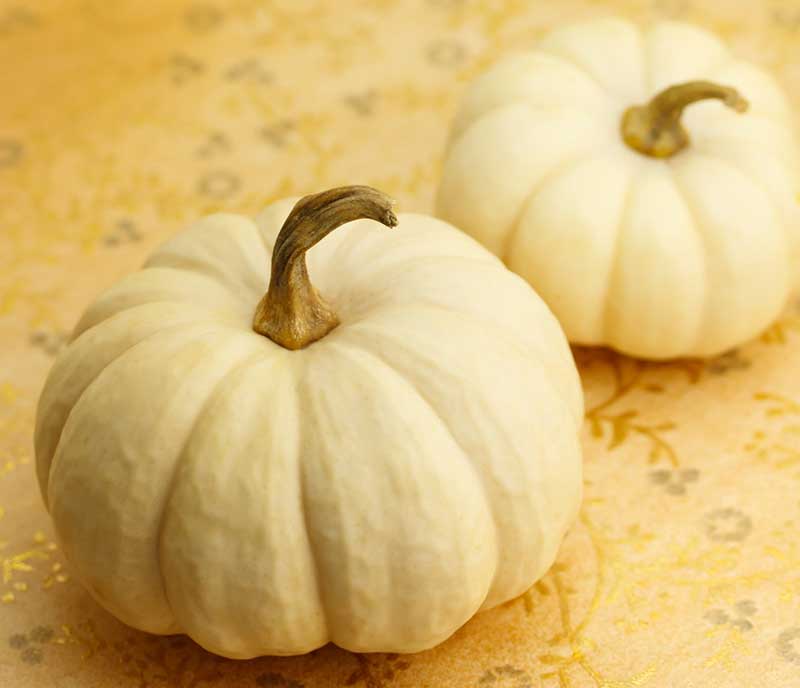
Baby Boo Pumpkins
Baby boo pumpkins are not typically consumed due to their small size and lack of flesh.These pumpkins are small and white, resembling miniature pumpkins. While baby boo pumpkins are not commonly eaten, they can be used for decorative purposes
Big Max Squash
Big Max squash has a mild, subtly sweet flavor and a firm and dense flesh. These squash are extremely large, often growing up to 100 pounds or more, with bright orange skin. This type of squash squash is a good source of vitamin A, dietary fiber, and essential minerals like potassium and magnesium.
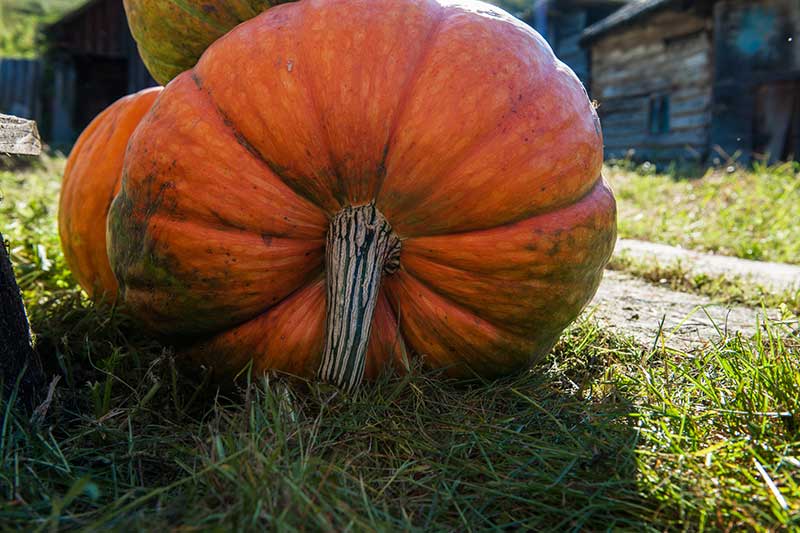
Big Moon Pumpkins
Big Moon pumpkins are large pumpkins with a classic round shape and bright orange skin. They have a mild, slightly sweet flavor and a smooth, fibrous texture. Big Moon pumpkins are often used for carving or making homemade pumpkin puree. They are low in calories and a good source of vitamins A and C.
Charisma Pumpkins
Charisma pumpkins are small to medium-sized pumpkins with a deep orange color and a smooth skin. They have a mildly sweet flavor and a tender, moist texture. Charisma pumpkins are versatile and can be used for baking, roasting, or making pumpkin puree. They are a good source of vitamins A and C, potassium, and fiber.
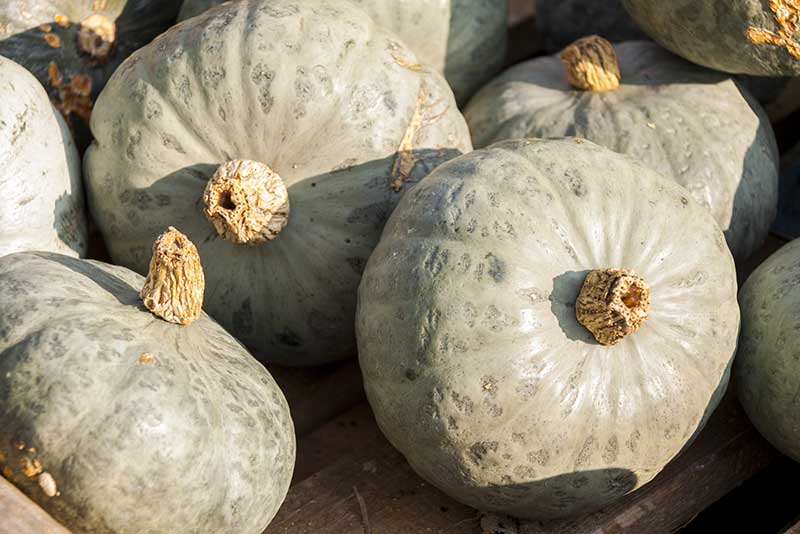
Blue Prince Pumpkins
Blue Prince pumpkins have a mild, sweet flavor with a firm and slightly fibrous flesh. These pumpkins have a unique, deep blue skin with distinctive ridges. Blue prince pumpkins are rich in vitamins A and C, as well as antioxidants.
Bonbon Squash
Bonbon squash has a rich, sweet flavor with notes of chestnut and hazelnut and a smooth and creamy flesh. These squash have a small to medium size, with a pale green or beige skin. Bonbon squash is a good source of dietary fiber, vitamins A and C, and minerals like potassium and magnesium.
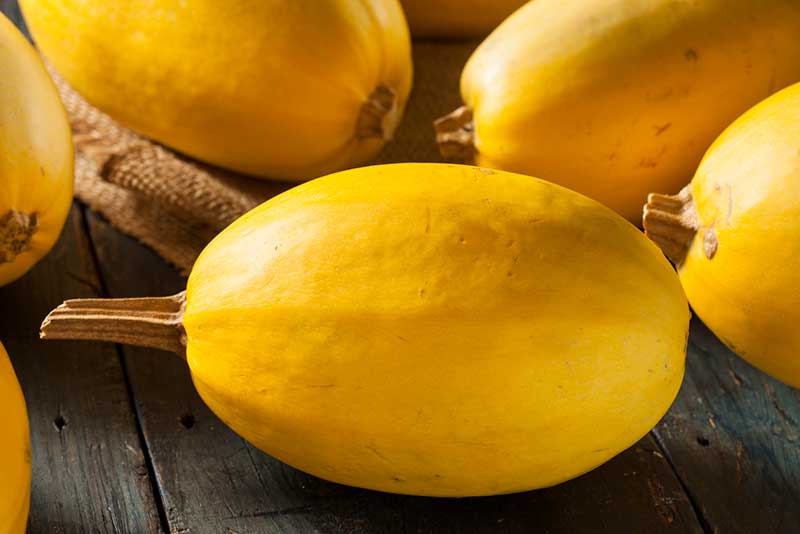
Spaghetti Squash
As the name suggests, spaghetti squash has spaghetti-like strands after it’s cooked. Its flavor is mild and slightly sweet. The skin is yellow or ivory. This squash is low in calories and high in dietary fiber, making it a nutritious option for those watching their weight or seeking to increase their fiber intake.
Check out 50 spaghetti squash recipes to help inspire new ways to cook this versatile squash!
Connecticut Field Pumpkins
Connecticut Field pumpkins are large pumpkins with a round shape and a bright orange skin. They have a mild, earthy flavor and a coarse, fibrous texture. Connecticut Field pumpkins are commonly used for carving or making pumpkin pies. They are a good source of vitamins A and C, potassium, and fiber.
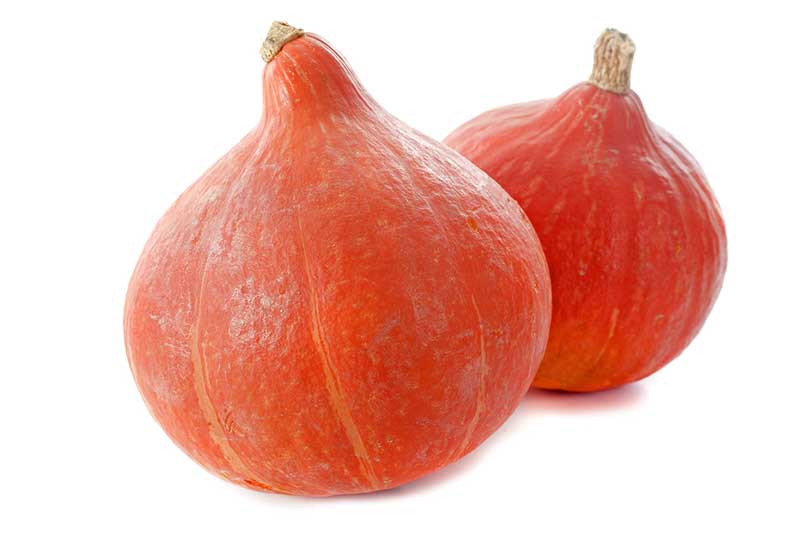
Red Kuri Squash
With a smooth and creamy texture, red kuri squash offers a chestnut-like flavor. Its skin is deep orange with a curved shape. This squash is rich in vitamin A and beta-carotene, supporting eye health and providing antioxidant benefits.
Cinderella’s Carriage
Cinderella’s Carriage squash, also known as Rouge vif d’Etampes, is a French heirloom squash. It has a flattened shape, deep orange-red color, and distinctive ribbed appearance. The flesh is dense, sweet, and flavorful, similar to sweet potatoes.
Cinderella’s Carriage squash is often used in soups, stews, or roasted as a side dish. It is rich in vitamins A and C, as well as dietary fiber.
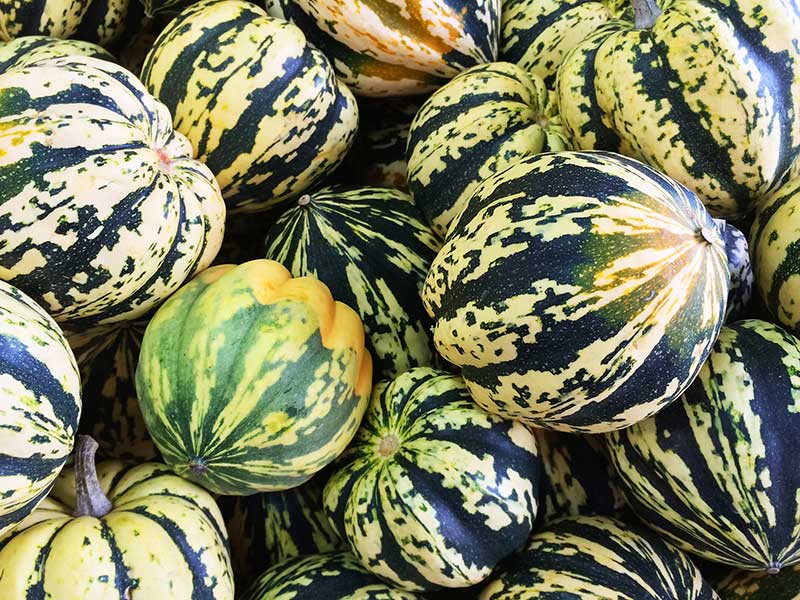
Carnival Squash
Carnival squash is a medium-sized winter squash with a unique patterned skin resembling a painted carnival mask. The flesh is creamy yellow with a sweet and nutty flavor. Carnival squash can be roasted, stuffed, or used in soups. It is packed with vitamins A and C, as well as potassium and fiber.
Dickinson Pumpkin
Dickinson pumpkin is a medium-sized pumpkin with a slightly elongated shape and a pale orange skin. It has a sweet, nutty flavor and a smooth, creamy texture. Dickinson pumpkin is often used for making pumpkin puree, pies, or soups. It is rich in vitamins A and C, iron, and dietary fiber.
Lumina Pumpkins
Lumina pumpkins are medium-sized pumpkins with a bright white skin. They have a mild flavor and a smooth, creamy texture. Lumina pumpkins are commonly used for carving or creating decorative displays. They are low in calories and a good source of vitamins A and C.
Prizewinner Pumpkins
Prizewinner pumpkins are large pumpkins with a round shape and an orange skin. They have a mildly sweet flavor and a smooth, relatively dry texture. Prizewinner pumpkins are often used for carving or making pumpkin pies. They are a good source of vitamins A and C, as well as potassium and fiber.
Red Warty Thing Squash
Red warty thing squash is a decorative winter squash with a bumpy, reddish-orange skin. It has a mild, slightly sweet flavor and a tender, creamy texture. Red warty thing squash can be roasted, baked, or used in soups. It is a good source of vitamins A and C, as well as potassium and fiber.
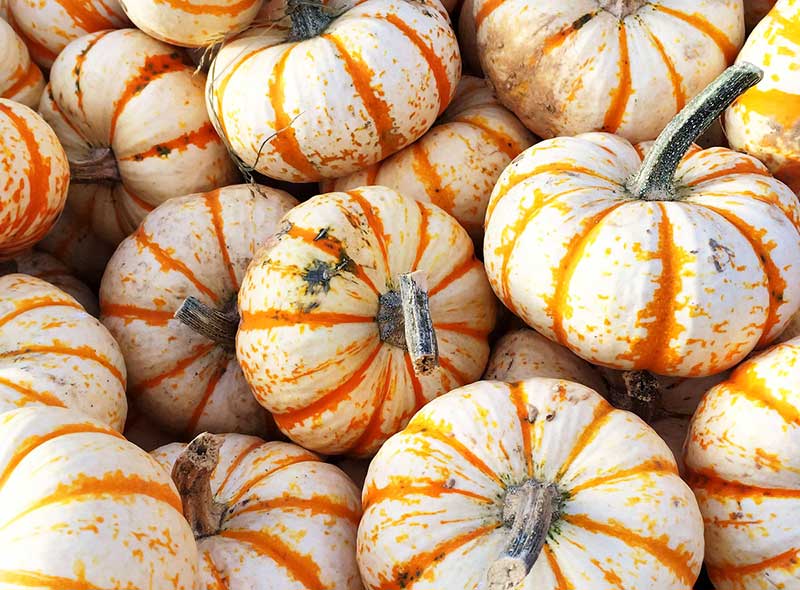
Sweet Dumpling Squash
Sweet dumpling squash has a delicate and sweet flavor with a creamy texture. Its skin features a white or cream-colored base with green stripes or spots. This squash is rich in vitamin A and dietary fiber, contributing to healthy eyesight and digestive function.
Hubbard Squash
Hubbard squash is a large winter squash with a bumpy, dark green or orange skin. It has a sweet, nutty flavor and a dry, starchy texture. Hubbard squash is commonly used in soups, stews, or roasted as a side dish. It is a good source of vitamins A and C, as well as potassium and fiber.
What’s the Difference Between a Squash and a Gourd?
Squashes and gourds, though they share many similarities, are distinctly different in several ways.
Squashes, belonging to the Cucurbitaceae family, are usually classified as either summer or winter squash. Summer squashes like zucchini are harvested while immature when the rind is still tender and edible. On the other hand, winter squashes such as butternut and acorn are allowed to fully mature before harvest, resulting in a hard, inedible rind but a sweet, rich flesh inside.
Gourds, also members of the Cucurbitaceae family, are generally harvested when mature. They have hard, inedible rinds and often inedible flesh.
Gourds are primarily used for decorative purposes, thanks to their variety of shapes, sizes, and colors. They are also used for crafting, and in some cultures, as musical instruments.
In summary, while both squashes and gourds come from the same plant family, squashes are typically grown for their edible flesh, whereas gourds are often utilized for their ornamental appeal.
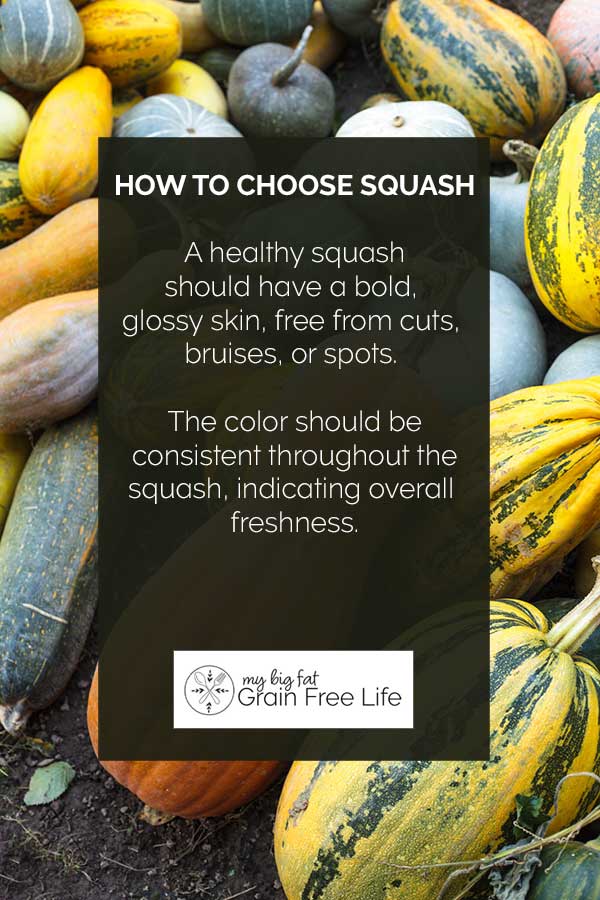
How to Choose Summer Squash
- Appearance: A healthy squash should have a bold, glossy skin, free from cuts, bruises, or spots. The color should be consistent throughout the squash, indicating overall freshness.
- Size Matters: When it comes to summer squash, smaller is often better. Squash that are less than eight inches in length tend to be more tender and have a more delicate flavor as compared to larger ones. The seeds are also smaller and easier to eat.
- Weight: The squash should feel firm and heavy for its size. This indicates that it’s full of juice and hence, fresh. Light or hollow squash may be overripe or have lost their freshness.
- Stem: Check the stem of the squash. It should be bright in color and firm. A soft or dry stem could be a sign of an old squash.
- Smell: Fresh squash has a mild, somewhat sweet smell. An unpleasant or strong odor usually signifies that the squash is spoiled or overripe.
- Test the Skin: The skin of the summer squash should be fairly firm but not overly hard. A quick test is to press your nail into it. If it breaks the skin easily, it’s fresh.
How to Choose Winter Squash
When you are shopping at the grocery store for winter varieties of squash, here’s what you need to look for:
- Examine the Skin: The skin of a ripe winter squash needs to be thick and hard. It should not be easily punctured or scratched away with your fingernails. A shiny skin could indicate that the squash was picked before it was completely ripe.
- Check the Color: The color should be bold in color and consistent all around. Any signs of green, except in varieties where this is the norm, could indicate the squash is underripe. On the other hand, avoid squash with brown or soft spots, which signals overripeness or spoilage.
- Feel the Weight: A ripe squash should feel heavy for its size. This means the inside is packed with nutrients and juicy flesh. A squash that feels too light may be dried out or hollow inside.
- Inspect the Stem: The stem of a winter squash should be dry and corky. Avoid squash with moldy or moist stems, as they could signal the squash has started to rot.
How to Store Squash
Storing squash properly is essential to maintain freshness. The best ways to store summer squash and winter squash differ based on their category. Follow the instructions below for storing all types of squash.
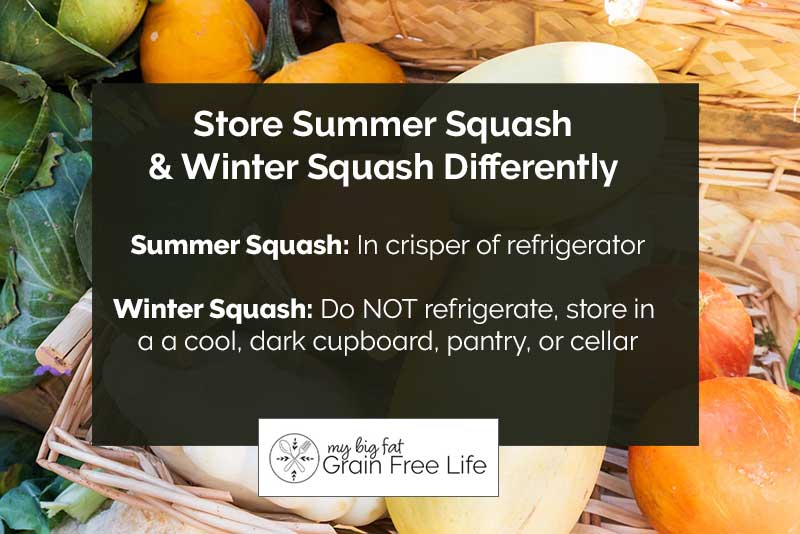
How to Store Summer Squash
- Don’t Wash Before Storing: It may seem counterintuitive, but washing summer squash before storage can promote mold growth and speed up spoilage. It’s best to wash your squash just before you’re ready to use it.
- Ideal Storage Location: Store your summer squash in the crisper drawer of your refrigerator. This area has the right balance of humidity necessary to keep the squash fresh without encouraging bacteria or mold growth.
- Optimal Temperature: The ideal storage temperature for summer squash ranges between 45 – 50 degrees Fahrenheit. Your refrigerator should be set to this temperature for optimal longevity.
- Use within One Week: For the best quality, try to use summer squash within one week of purchase. After a week, it starts to lose its firmness and nutritional value.
- Avoid Plastic Bags: Never store squash in airtight plastic bags as these can lock in moisture and promote rot. Instead, use a breathable cloth bag or keep them loosely in the crisper.
How to Store Winter Squash
- Curing Squash: Before storage, squash needs to be cured. Simply leave the squash in a sunny and well-ventilated area for 10 to 14 days. This process toughens the skin, sealing it off from potential decay and infection.
- Temperature and Humidity: The ideal storage temperature for winter squash is between 50-55°F (10-13°C), with a relative humidity of 50-70%. A basement or cellar is ideal. If you do not have these, a cool, dark cupboard will do.
- Proper Spacing: Don’t pile your winter squash together. It’s best to allow air circulation by placing them side by side without touching.
- Regular Check: Regularly inspect the stored squash. If there are any signs of decay, use the affected squash immediately to prevent the rot from spreading.
- Do Not Refrigerate: Unless it’s cut, do not refrigerate the squash. The refrigerator’s cold temperature can cause the squash to rot quickly.
*By following these steps, your winter squash can last between 2-6 months!
Does Squash Freeze Well?
It’s great to know that frozen vegetables retain most nutrients, but not all types of squash freeze well. Acorn squash, butternut squash, and spaghetti squash are all varieties of squash that freeze well.
Ways to Cook Summer Squash
- Grilled Summer Squash: Grilling squash adds a delightful char and robust smoky flavor to it. Simply slice your squash, brush with olive oil or avocado oil, season with salt, pepper, and your favorite herbs then grill to perfection.
- Stir-Fried Summer Squash: For a quick, light dish, try stir-frying squash with other colorful vegetables. A dash of coconut aminos and a sprinkle of sesame seeds can add an Asian touch to your meal.
- Steamed Summer Squash: Steaming is a healthy cooking method that preserves the maximum nutrients in your squash. Serve it with a squeeze of lemon and fresh herbs as a simple side dish.
- Squash Salad: Raw squash is crunchy, slightly sweet, and refreshing. Toss thinly sliced summer squash in your salad for a crunchy texture and a vitamin boost.
- Roasted Summer Squash: Roasting brings out the natural sweetness of the squash. Dice it, toss it in olive oil, add your favorite seasonings, and roast until golden. Enjoy it as a hearty side with your favorite protein.
- Stuffed Summer Squash: Halve the squash lengthwise, scoop out a bit from the middle, and stuff it with a mixture of veggies, protein, and grain. Bake until the squash is tender.
- Squash Pasta: Thinly sliced or spiralized, squash makes a delicious and healthy AIP pasta (or gluten-free vegan pasta).
Ways to Cook Winter Squash
- Roasting: The most common method to cook winter squash. Cut the squash into halves, scoop out the seeds and place it face down on a baking sheet. Roast at 375°F until tender, usually for about 30-45 minutes. Some people like to make it sweet by adding butter and maple syrup to it while it roasts. Adding warm spices like cumin and crushed coriander seeds can be a great variation as well.
- Steaming: Cut the squash into chunks and steam over boiling water for 7-10 minutes. This method retains the most nutrients and is great for making baby food.
- Boiling: Boil peeled and cubed squash for about 15-20 minutes or until tender. This method works well for making mashed squash or soups, like my roasted butternut squash soup.
- Slow-Cooker/Crockpot: Cut your squash in half, scoop out the seeds and place in your slow-cooker. Add about an inch of water and cook on low for 4-6 hours. This is ideal for making squash that will be pureed for soups or sauces.
- Grilling: Cut squash into slices, brush with olive oil and grill over medium heat for 5-7 minutes each side. This gives the squash a wonderful smokey flavor.
Check out these tasty AIP Pumpkin recipes for some inspiration.
Health Benefits of Squash
There’s a lot of nutrition in squash. Here are some of the health benefits of squash.
- Rich in Nutrients: Squashes are packed with vitamins A, C, E, B, potassium, magnesium, and fiber, which contribute to overall wellness.
- Promotes Heart Health: The high levels of magnesium and potassium in squash can reduce blood pressure, which in turn supports a healthy heart.
- Boosts Immunity: Squashes are rich in Vitamin C, which boosts immune function and aids in fighting off infections.
- Supports Digestive Health: Owing to its high fiber content, squash promotes a healthy digestive system and helps prevent constipation.
- Improves Eye Health: The beta-carotene present in squash converts into Vitamin A, crucial for healthy eyesight.
- Weight Management: Squashes are low in calories and high in fiber, making them a great food for weight control.
- Regulates Blood Sugar: The high fiber content slows down the absorption of sugar, helping to regulate blood sugar levels.
- Promotes Healthy Skin: Vitamins A and C in squash contribute to skin health, promoting hydration, elasticity, and fighting off damage caused by free radicals.
- Prevents Cancer: Squashes are rich in antioxidants that help reduce oxidative stress, potentially preventing certain types of cancer.
- Boosts Bone Health: Squashes have a good amount of Vitamin K and calcium, supporting bone health.
- Anti-Inflammatory Benefits: Squash has anti-inflammatory properties, which can reduce inflammation in the body.
- Improves Lung Health: Vitamin A in squash can promote lung health, particularly in smokers or former smokers.
- Supports Mental Health: The nutrients in squash like potassium and magnesium help improve brain function and mental health.
- Aids in Healthy Pregnancy: Squash is rich in folate which is beneficial for a healthy pregnancy and fetal development.
- Prevents Anemia: The presence of iron makes squash suitable for preventing and treating anemia.
- Lowers Cholesterol: The dietary fiber in squash helps lower cholesterol by binding with bile acids in your digestive tract.
- Promotes Muscle Health: Squash contains magnesium which is vital for the maintenance of muscle health.
- Boosts Hair Health: Vitamin A in squash helps in the production of sebum, which keeps hair moisturized and healthy.
- Improves Energy Levels: Squash is a good source of B-vitamins, which are known to boost energy levels.
- Reduces Insomnia: The magnesium content in squash aids in improving sleep quality by helping reduce insomnia.
Final Summary
All types of squash, from butternut and acorn to spaghetti and buttercup, are great additions to a healthy diet. Each variety brings its own unique flavor, texture, and nutrient profile. From being an excellent source of vitamins, minerals, and fiber to aiding in digestion and improving vision, the health benefits of this versatile vegetable are simply extraordinary.
Additionally, simple storage guidelines like keeping squash in a cool, dry place can help retain their freshness for a long time. The preparation of squash is equally convenient and versatile – be it roasting, steaming, or blending into soups.
Sources
- https://health.clevelandclinic.org/benefits-of-squash/
- https://foodrevolution.org/blog/health-benefits-of-squash/
- https://www.healthline.com/nutrition/zucchini-benefits
- https://www.stylecraze.com/articles/benefits-of-squash-for-skin-hair-and-health/
- https://www.everydayhealth.com/diet-nutrition/potential-health-benefits-of-butternut-squash/


